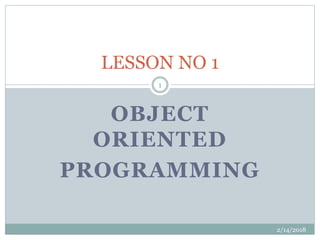Object Oriented Programming
- 2. Features of OOP ’éŚ 1.Class ’éŚ 2.Object ’éŚ 3.Data Abstraction ’éŚ 4.Encapsulation ’éŚ 5.Inheritence ’éŚ 6.Polymorphism ’éŚ 7.Dynamic Binding 2/14/2018 2
- 3. CLASS ’éŚ A class is a blueprint or prototype, that defines the variables and the methods common to all objects of a certain kind. ’éŚ Static variable- which contain information that is shared by all the instances of the class. ’éŚ Static method- which can be invoked directly from the class. 2/14/2018 3
- 4. Objects 2/14/2018 4 An object is a unique entity, that contains data and functions together in an OOP language
- 5. DATA ABSTRACTION 2/14/2018 5 ’éŚ It refers to the act of representing essential data without including the background details of explaination.
- 6. Polymorphism 2/14/2018 6 ’éŚ Ability of an object to take than one form.
- 7. Inheritance 2/14/2018 7 ’éŚ It is the capability of one class of things to inherit capabilities or properties from another class
- 8. Dynamic Binding 2/14/2018 8 Process to link function call with function signature at runtime.
- 9. Encapsulation 2/14/2018 9 ’éŚ The wrapping up of data and operations of functions into a single unit is known as encapsulation
- 10. Advantages of OOP 2/14/2018 10 ’éŚ 1.It gives stress on data items Rather on functions. ’éŚ 2.Offers code reusability. ’éŚ 3.Highly beneficial to solve complex program. ’éŚ 4.Makes it easy to maintain and modify existing code.
- 11. Disadvantages of OOP 2/14/2018 11 ’éŚ 1.classes are overly generalised. ’éŚ 2.Needs proper planning and proper design for OOP. ’éŚ 3.design is tricky. ’éŚ 4.Relationship between classes becomes artificial at times.
- 12. DIFFERENCE BETWEEN POP AND OOP 2/14/2018 12 POP OOP 1.THE STRESS IS PUT ON FUNCTION RATHER THAN THE DATA. 1.THE STRESS IS PUT ON DATA RATHER THAN ON FUNCTION. 2.IT ALLOWS THE DATA TO FLOW FREELY THROUGHOUT THE PROGRAM. 2.THE DATA IS RESTRICTED TO A SPECIFIC PROGRAM AREA. 3.IT DOES NOT HAVE ANY ACCESS SPECIFIER 3.IT HAS 3 ACCESS SPECIFIERS VIZ. public , private, protected. 4.IT FOLLOWS TOP-DOWN PROGRAMMING APPROACH. 4.IT FOLLOWS BOTTOM ŌĆōUP PROGRAMMING APPROACH.











